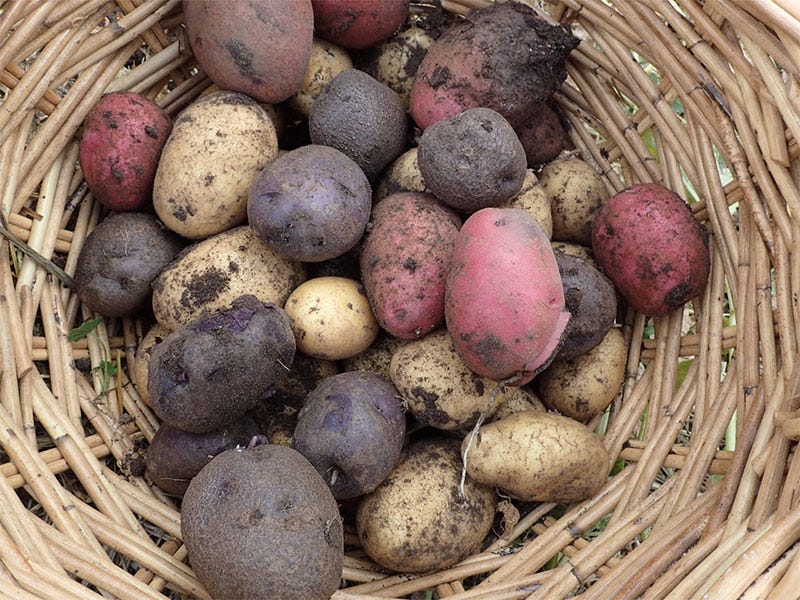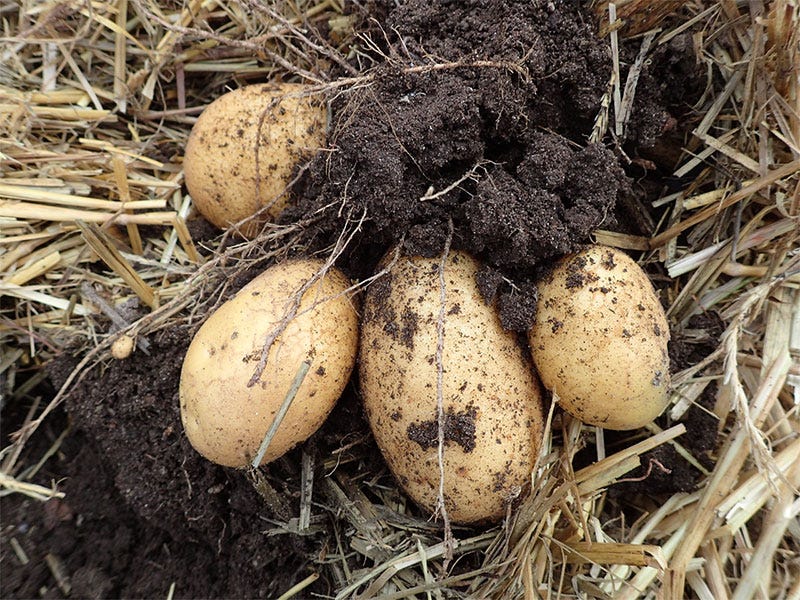Underground Treasure: How to Harvest and Store Root Vegetables


In 1910, my great-uncle patented the Hinman Potato Planter, a device pulled behind a horse that supposedly made planting potatoes easier and faster. I never saw it in action, but I firmly believe the love of potatoes, and other root vegetables, has a genetic component for me, which is why they are a favorite of mine to grow. Even though they tend to be less expensive than some of the showier vegetables in the grocery store, you can’t beat the flavor, or the amazing varieties, of homegrown potatoes, carrots, onions, and beets.
As the season wanes, it’s time to bring in this underground harvest to enjoy throughout the cooler months. The good news is most root vegetables are excellent candidates for long-term storage as long as they are cured and kept properly.

When to Dig Potatoes
Potatoes are one of those lovely vegetables that will wait to be harvested until you’re ready. New potatoes throughout the summer are always a treat at suppertime, but if you want to put them up for the long haul, dig them a couple of weeks after the plant dies, although you can certainly let them stay in the ground for weeks after that as long as you don’t have prolonged wet weather.
Ready to harvest your potatoes? Check out our selection of gardening and harvesting tools here.
When you’re digging them, be careful not to nick or cut the potatoes. If you do, use them immediately. Gently knock off as much of the large chunks of dirt as possible, then allow them to cure by spreading them out of the sun in a dry area with a temperature of 45-60 degrees F. for a couple of weeks. This allows the skins to firm up, so they keep longer. After they are cured, brush off extraneous soil (but don’t wash them because it shortens their storage life), and store them in baskets or bins, with some air circulation, covered with burlap or a towel to prevent the sun from burning the skin. Store in a cool, dry place. While 32-40 degrees is ideal, they will still keep well in warmer conditions.

How to Store Beets
Beets are one of my favorites, although I didn’t start eating them until I was an adult. Harvest them to use in salads or for quick meals as soon as they’re just over an inch in diameter. If you want them to keep longer, wait until they’re a couple of inches across. Dig them after the soil has been dry for a few days to keep the dirt from sticking.
After carefully digging them, cut the greens to within an inch of the beetroot so it doesn’t bleed all over the place. Store them in a sealed container, such as a trash barrel (for a big harvest) or bucket, with sand, sawdust, or peat moss. Keep them in a cool place just over freezing, such as an unheated, but insulated, garage or cold basement, if you don’t have a root cellar. They might not last the entire winter, but beets will usually keep for 2-3 months.

How to Store Carrots for the Winter
Carrots are another one of those wonderfully laid-back veggies that aren’t terribly time sensitive. I’ve even harvested them in the snow! As a matter of fact, you can leave carrots in the ground over the winter if you insulate them with 18 to 24 inches of leaves or straw. Put a tarp over the top to keep your natural blanket from blowing away in windier regions.
Did you know you can also ferment carrots for a delicious snack? Learn how here.
There are several ways to keep carrots throughout the winter. You can dig them, wash them off, and keep them in a container with sand, sawdust, or peat moss like you do beets. But if you don’t have a root cellar, you can also store them in 5-gallon buckets buried in the ground. This takes a little preparation before you dig the carrots, but it works very well and will keep them until the following spring.

The Bucket Method for Storing Carrots:
-
To prepare to keep carrots in the ground, dig a hole (or two if you are using more than one bucket) that is deep enough to hold a 5-gallon bucket and keep it flush with ground level. Use a food grade plastic bucket and be sure you clean it thoroughly, preferably with a bleach solution. You'll also want to have a few straw bales on hand, as well as a tarp.
-
After you dig the carrots, knock off any excess soil, and wash them in a mild bleach and water solution. This helps prevent the area from speeding decomposition. Pack the carrots in the buckets just like you are stacking firewood. Once you are 3 -4 inches from the top, crumble up some newspapers to take up space before placing a lid securely in place. All you have to do is place the bucket in the pre-dug hole and cover it with a straw bale, or bales.
-
Next, place a tarp over the top to make it easier shake off any snow as the winter progresses. When you need carrots all you have to do is remove the tarp over the straw bale, open up the bucket and take out what you need. If you see any carrots that look like they are soft or beginning to rot, remove those to prevent the rest of the batch from going bad too. By springtime, you might notice some very tiny roots starting to grow, but all you have to do is to brush those off when you clean them before using them.

When are Onions Ready to Harvest
Onions or another easy root vegetable that is used in many dishes. There are a number of varieties that last well into the winter without softening at all. My favorite is ‘Copra,’ and ‘Candy’ is another that stores well (although I don’t think quite as long as ‘Copra’).
Once onions flop over in the garden, they’re ready to harvest. Many times, you can simply pull them from the soil, although tougher characters might need a garden fork to coax them out. Like some other vegetables, onions need to be cured for best storage results. Once you harvest them, spread them out on a tarp or table in a warm (70-80 degrees) area that is breezy, yet out of direct sunlight, for a couple of weeks. Once they’re dried, trim the roots, as well as the tops to within an inch of the onion. You can keep them in an open weave basket or bags in a cool (35-40 degrees), dark place.
There’s a particular satisfaction in harvesting root vegetables and storing them for the winter. These are the staples that sustain us throughout the cold months. It might not be the brilliant flash of flavor from basil or tomatoes at the height of summer, but they are the foundations of the comfort food that nourishes us in this season of rest.
